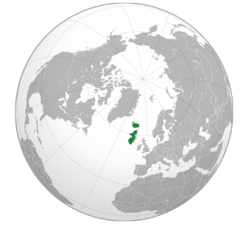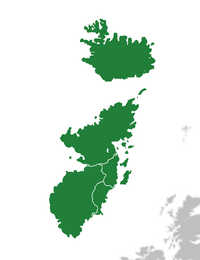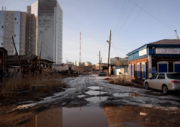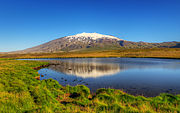Nelborne: Difference between revisions
No edit summary |
m (→Religion: typo) |
||
| (42 intermediate revisions by 2 users not shown) | |||
| Line 1: | Line 1: | ||
{{WIP}} | {{WIP}} | ||
{{About|the | {{About|the region|the political and economic union|Nelborne Union|the island|Nelbecia}} | ||
{{see also|Existence of the Nelborne}} | |||
{{Infobox continent | {{Infobox continent | ||
|title = Nelborne | |title = Nelborne | ||
| Line 57: | Line 58: | ||
}} | }} | ||
The '''Nelborne''' [[Existence of the Nelborne|is]] a {{wp|region}} and {{wp|archipelago}} located in {{wp|northwestern Europe}}. Situated | The '''Nelborne''' [[Existence of the Nelborne|is]] a {{wp|region}} and {{wp|archipelago}} located in {{wp|northwestern Europe}}. Situated on the {{wp|Atlantic Ocean}}, the islands have a combined area of ~325,00 km2, with a population of approximately 22 million. The region contains the three [[Nelbec countries|Nelbec]] countries of [[Alquiya]], [[Lormotia]], and [[Seketan]], along with {{wp|Iceland}}, [[New Svealand]], and the [[Kingdom of Trjebia]]<small>{{ref|a|1}}</small>. | ||
[[Human settlement of the Nelborne]] occurred during the {{wp| | [[Human settlement of the Nelborne]] occurred during the {{wp|last glacial period}} where {{wp|homo sapiens}} migrated from {{wp|Europe}}. The [[Classical Nelborne|Classical era of the Nelborne]] encompassed [[North Nelbecs|North Nelbec]], [[South Nelbecs|South Nelbec]], and [[Sjezon]] polities centred on the [[Treb Bay]]. By the 3rd century AD, the Nelborne entered into [[Middle Nelborne|dark ages]]. The [[Christianization of the Nelborne]] in the 9th century was soon followed by [[vikings in the Nelborne|viking invasions]] which saw the [[Norse settlement of the Nelborne|Norse settlement]] of [[New Svealand]] and {{wp|Iceland}}. The [[Early modern Nelborne|early modern era]] saw the kingdoms of [[Kingdom of Alquiya|Alquiya]] and [[Kingdom of Seketan|Seketan]] become fierce rivals over {{wp|hegemon}} regional power, with further division occurring during the [[Nelborne Reformation]]. | ||
After an [[Union of the Nelbecs|Alquiyan-led personal union with Seketan]] endured for almost a century, the [[Nelbec Empire]] was established in 1884, later [[Nelbec conquest|occupying Danish territories]] and [[Nelborne Front|invading an independent Lormotia and New Svealand during World War I]] before ultimately [[Collapse of the Nelbec Empire|collapsing in 1919]]. [[Trjebian dispute|Disputes]] regarding the [[Nelborne conflict|boundary of ''Trjebia'']] and between New Svealand and the [[Lormot Republic]] led to the [[Nelborne War]], which ended in 1942 inconclusively. After the [[Nelborne Spring]] where Alquiya and Seketan began their transition to democracies, the [[1981 Alquiyan-Seketese crisis]] was resolved by the [[Treaty of Joghen]] which began the development of [[Nelborne integration]]. The [[Nelbec Council]] and [[Nelborne Union]] were established in 1982 and 2004 respectively. | |||
The Nelborne represents an integral part of {{wp|European culture}}. Its socio-cultural characteristics are influenced by [[Nelbec countries|Nelbec]], [[Nordic Nelborne|Nordic]], and [[Sjezons|Sjezonic]] [[culture of the Nelborne|cultures]], the development of {{wp|Western Christianity}}, and the region's relative [[Nelborne isolation|isolation from the rest of Europe]]. The [[demographics of the Nelborne|contemporary people of the Nelborne]] are primarily of [[North Nelbecs|North Nelbec]], [[South Nelbecs|South Nelbec]], {{wp|North Germanic peoples|North Germanic}}, and [[Trjebians|Trjebian]] origin. [[Seketese language|Seketese]] is the most commonly spoken native language; [[English language in the Nelborne|English]] and [[French language in Seketan|French]] are the most common {{wp|second language|second languages}}. | |||
The [[Nelborne Union]] is the most prominent {{wp|international organization}} aiming to represent the Nelborne region on a political level. The [[Nelbec Council]] aims to promote cooperation within the [[Nelbec countries]]. Every sovereign state in the Nelborne is a member of the {{wp|Council of Europe}}. The historical [[Nelborne isolation|isolation of the Nelborne]] continues to factor in the politics of Nelborne states regarding {{wp|European integration}}. | The [[Nelborne Union]] is the most prominent {{wp|international organization}} aiming to represent the Nelborne region on a political level. The [[Nelbec Council]] aims to promote cooperation within the [[Nelbec countries]]. Every sovereign state in the Nelborne is a member of the {{wp|Council of Europe}}. The historical [[Nelborne isolation|isolation of the Nelborne]] continues to factor in the politics of Nelborne states regarding {{wp|European integration}}. | ||
| Line 70: | Line 75: | ||
==Definition and boundaries== | ==Definition and boundaries== | ||
In its most inclusive definition, the Nelborne includes the islands of [[Nelbecia]], {{wp|Geography of Iceland|Iceland}} and [[list of islands of the Nelborne|surrounding smaller islands]]. The inclusion of {{wp|Iceland}} is occasionally omitted in many political contexts regarding the island country's stronger {{wp|Foreign relations of Iceland|connection with mainland Europe}}. | |||
The Nelborne as a strictly geographical term is predominantly considered to be within {{wp|northern Europe}}, sometimes {{wp|northwestern Europe}} but seldom {{wp|western Europe}}. The countries of the Nelborne are generally considered to be part of the {{wp|Western world}}, although this identity is weaker in the [[Nelbec countries]]. | |||
==History== | ==History== | ||
| Line 83: | Line 90: | ||
===Modern=== | ===Modern=== | ||
[[Union of the Nelbecs|Alquiya and Seketan]] under the shared monarch of [[Fjedor IV and II]] formally united into a single state under the [[Nelbec Imperial Acts]], establishing what would become the [[Nelbec Empire]]. The state under [[Elzin II]] espoused [[Nelbecism|pan-Nelbec]] identity and [[Nelbec occupation of Greenland and Iceland|occupied Danish territories]] with the diplomatic support of the {{wp|German Empire}}, forming a military alliance in 1889. In 1914, the [[Nelbec Empire]] [[Lormotia campaign|attacked Lormotia]] and [[invasion of New Svealand (1914)|invaded New Svealand]], starting the [[Nelborne Front]] of {{wp|World War I}}. The empire was decisively defeated in 1919. The [[Seketese Civil War]] began shortly after. The [[Civil Council]] in Alquiya established the [[Republic of the South Nelbecs and Trjebs]] which would later become the [[Alquiya|Republic of Alquiya]]. The [[Kjedorates]] emerged victorious in the Seketese Civil War and established the [[Second Seketese Republic]]. | |||
==Geography== | |||
The Nelborne is situated in the {{wp|Atlantic Ocean}} between the {{wp|North Sea}} and the [[Nelborne Sea]] in {{wp|northwestern Europe}}. The region contains two main islands, [[Nelbecia]] and {{wp|Iceland}}, as well as thousands of [[list of islands of the Nelborne|surrounding smaller islands]]. Most of Nelbecia is highly mountainous with sprawling ravine systems and {{wp|taiga}}, with the central [[Trjebian plains]], the [[Fjeskan plains]] to the northeast, and {{wp|tundra}} forming to the north. | |||
The principal landmasses of the Nelborne {{wp|Pangaea#Rifting and break-up|split from Pangaea 237 million years ago}}, eventually forming the two islands of [[Nelbecia]] and {{wp|Geography of Iceland|Iceland}}. The [[Fjoške]] and [[Yerjtan]] mountain ranges strike through the north-south axis of the Nelborne, with the entire region holding extensive {{wp|volcanic}} activity. | |||
{{Gallery | |||
| title = Gallery of Nelborne areas | |||
| align = | |||
| footer = | |||
| style = | |||
| state = | |||
| height = | |||
| width = | |||
| perrow = | |||
| mode = | |||
| whitebg = | |||
| noborder = | |||
| captionstyle = | |||
| File:View to Geiranger from Flydalsjuvet, 2013 June.jpg | |||
| Resort village in the state of [[Anecz]], [[Alquiya]] | |||
| alt1= | |||
| File: Panorama von Monaco-La Turbie.jpg | |||
| View of [[Dremmem]] on the [[Treb Bay]]. | |||
| alt2= | |||
| File: Haglebunatten.JPG | |||
| {{wp|Taiga}} in [[Nelderjen]], [[Seketan]]. | |||
| alt3= | |||
| File:20190502 Widok na Budę z brzegu Dunaju 0653 1875 DxO.jpg | |||
| View of [[Conelibek]], [[Seketan]] from [[Lake Seketan]]. | |||
| alt4= | |||
| File: Stara planina2.JPG | |||
| View of the [[Fjeskan plains]] in [[Falanda]], [[New Svealand]]. | |||
| alt5= | |||
| File: View of Ljubljana, Slovenia. (52294456853).jpg | |||
| View of [[King Vjade II square]] in [[Vlyade]], [[Lormotia]]. | |||
| alt5= | |||
| File:BB-67400 Estaque Marseille FRA 001.JPG | |||
|View of the [[Green line (Avro)|Green line]] in suburban [[Avro]], [[Alquiya]]. | |||
|alt6 = | |||
| File:Calanques.jpg | |||
| Rocky shores in the state of [[Ciamyn]], [[Alquiya]]. | |||
|alt7= | |||
| File:Libek na lycyn slum.png | |||
| Urban slum in [[Libek ná Lycyn]], [[Seketan]]. | |||
| File:Snæfellsjökull in the Morning (7622876302).jpg | |||
| {{wp|Snæfellsjökull}}, {{wp|Iceland}} in the morning. | |||
}} | |||
==Politics== | ==Politics== | ||
Of the six sovereign states within the Nelborne, three are {{wp|constitutional republic}}s and three are {{wp|constitutional monarchy|constitutional monarchies}}. [[Alquiya]] is the only {{wp|presidential system}}, with the remaining sovereign states operating under {{wp|parliamentary system}}s. | |||
{{wp|International law}} in the Nelborne is upheld by various multilateral treaties and organizations, beginning with the [[Treaty of Joghen]] in 1981. | |||
===Regional organizations=== | ===Regional organizations=== | ||
The [[Nelbec Council]] and the [[Nelborne Union]] are the two | The [[Nelbec Council]] and the [[Nelborne Union]] are the two principle {{wp|international organizations}} that function in the Nelborne. | ||
No state in the Nelborne is a {{wp|European Union}} member state, and only {{wp|Iceland}} is a member of the {{wp|European Economic Area}}. {{wp|Euroscepticism}} is predominant, although {{wp|European integration}} is more popular in the [[Nordic Nelborne|Nordic Nelborne countries]]. | |||
== | ==List of sovereign states== | ||
{| class="sortable wikitable" | {| class="sortable wikitable" | ||
! style="line-height:95%; width:2em" class="unsortable" | [[Armorial of Nelborne|Arms]] | ! style="line-height:95%; width:2em" class="unsortable" | [[Armorial of Nelborne|Arms]] | ||
| Line 104: | Line 169: | ||
| style="text-align:center;"| [[file:Coat of Arms of Alquiya.png|75px]] | | style="text-align:center;"| [[file:Coat of Arms of Alquiya.png|75px]] | ||
| style="text-align:center;"| [[File:Flag of Alquiya.svg|100px]] | | style="text-align:center;"| [[File:Flag of Alquiya.svg|100px]] | ||
| [[Alquiya]] | | [[Alquiya|Republic of Alquiya]] | ||
| style="text-align:right;"| 6,562,284 | | style="text-align:right;"| 6,562,284 | ||
| [[Vilderjen]] | | [[Vilderjen]] | ||
| Line 120: | Line 185: | ||
| style="text-align:center;"| [[file:Lormotia Coat of Arms.png|55px]] | | style="text-align:center;"| [[file:Lormotia Coat of Arms.png|55px]] | ||
| style="text-align:center;"| [[File:Flag of Lormotia.png|100px]] | | style="text-align:center;"| [[File:Flag of Lormotia.png|100px]] | ||
| [[Lormotia]] | | [[Lormotia|Kingdom of Lormotia]] | ||
| style="text-align:right;"| 3,562,553 | | style="text-align:right;"| 3,562,553 | ||
| [[ | | [[Vlyadel]] | ||
| Lormoyt ([[Lormotian language|Lormotian]])<br/>Lormojt ([[Seketese language|Seketese]]) | | Lormoyt ([[Lormotian language|Lormotian]])<br/>Lormojt ([[Seketese language|Seketese]]) | ||
| [[Lormotian language|Lormotian]] | | [[Lormotian language|Lormotian]] | ||
| Line 128: | Line 193: | ||
| style="text-align:center;"| [[File:Royal coat of arms.png|75px]] | | style="text-align:center;"| [[File:Royal coat of arms.png|75px]] | ||
| style="text-align:center;"| [[File:New Svealand Flag.png|100px]] | | style="text-align:center;"| [[File:New Svealand Flag.png|100px]] | ||
| [[New Svealand]] | | [[New Svealand|Kingdom of New Svealand]] | ||
| style="text-align:right;"| 4,452,357 | | style="text-align:right;"| 4,452,357 | ||
| [[Rosenburg]] | | [[Rosenburg]] | ||
| Line 136: | Line 201: | ||
| style="text-align:center;"| [[File:Coat of Arms of Seketan.png|75px]] | | style="text-align:center;"| [[File:Coat of Arms of Seketan.png|75px]] | ||
| style="text-align:center;"| [[File:Flag of Seketan.svg|100px]] | | style="text-align:center;"| [[File:Flag of Seketan.svg|100px]] | ||
| [[Seketan]] | | [[Seketan|Republic of Seketan]] | ||
| style="text-align:right;"| 6,426,108 | | style="text-align:right;"| 6,426,108 | ||
| [[Conelibek]] | | [[Conelibek]] | ||
| Line 153: | Line 218: | ||
==Demographics== | ==Demographics== | ||
===Languages=== | |||
The Nelborne has dozens of indigenous languages, entirely within the {{wp|Indo-European}} branches of {{wp|Germanic languages|Germanic}}, [[Nelbec languages|Nelbec]], and [[Sjezonic languages|Sjezonic]]. [[Seketese language|Seketese]], [[Alquiyan language|Alquiyan]], [[Svealandic language|Svealandic]], [[Lormotian language|Lormotian]], [[Trjebian language|Trjebian]], [[Wilsk language|Wilsk]], [[Fjeskan language|Fjeskan]], and {{wp|Icelandic language|Icelandic}} are the most spoken languages with more than 100,000 speakers. | |||
[[English language in the Nelborne|English]] and [[French language in Seketan|French]] are the most commonly learned {{wp|second language|second languages}}. English is increasingly being used as a ''{{wp|lingua franca}}'' in the Nelborne. | |||
===Religion=== | ===Religion=== | ||
Since the onset of the [[Nelborne Reformation]] in the 16th century, religiousity in the Nelborne has traditionally been defined by a north-south Protestant-Catholic division. The {{wp|Catholic Church}} is the most widespread religious instition, with {{wp|Catholics}} forming a majority in [[Alquiya]] and [[Lormotia]], with strong footings in regions of [[Seketan]] and [[New Svealand]]. Various {{wp|Protestant}} churches are dominant in Seketan, New Svealand, {{wp|Iceland}}, the [[Kingdom of Trjebia|Former Kingdom of Trjebia]]. | |||
==Culture== | ==Culture== | ||
{{see also|culture of Alquiya|culture of Seketan|culture of New Svealand|culture of Lormotia|culture of Trjebia|memes in the Nelborne}} | |||
The Nelborne represents an integral part of {{wp|European culture}}, primarily influenced [[Nelbec peoples|Nelbec]], [[Nordic Nelborne|Nordic]], and [[Sjezonic peoples|Sjezonic]] cultures. Each country of the Nelborne has its own national traditions and cultures, all originating from the [[Human settlement of the Nelborne|original human settlement of the Nelborne in the Neolithic era]] and the [[Indo-European migration to the Nelborne|Indo-European migration to the Nelborne in the 20th century BCE]]. The earliest attested cultures established states in the [[Classical Nelborne|Classical era of the Nelborne]]. | |||
Sovereign states of the Nelborne have separate national {{wp|media|media sectors}} and {{wp|creative industries}}, however there is a high degree of {{wp|cultural exchange}} and {{wp|regional integration}}. [[Dubbing in the Nelborne|Dubbing]] locally produced film and television into each country's national languages is a consistent and regular practice. Box-office and music sales charts within the Nelborne countries are generally grouped together. | |||
[[The Nelborne Times]], originally published in [[English language in the Nelborne|English]], since its founding in 1979, and [[French language in the Nelborne|French]], since the opening of its [[Conelibek]] office in 1983, is the most widely circulated newspaper and is currently published daily in 10 languages. | |||
==Notes== | |||
:1.{{note|a}} Due to the [[Trjebian dispute]], the state is commonly referred to as the ''Former Kingdom of Trjebia'' (''FKT'') in international affairs. The state is recognized as the ''Kingdom of Trjebia'' by [[Seketan]] and itself. [[Alquiya]] has referred to the state as the ''Trjebian kingdom in Dremmem'' since 1985. | |||
==See also== | ==See also== | ||
*[[ | *[[Existence of the Nelborne]] | ||
{{Nelborne topics}} | {{Nelborne topics}} | ||
Latest revision as of 22:00, 26 October 2023
This article is incomplete because it is pending further input from participants, or it is a work-in-progress by one author. Please comment on this article's talk page to share your input, comments and questions. Note: To contribute to this article, you may need to seek help from the author(s) of this page. |
 Orthographic projection of the Nelborne  | |
| Population | 22 million |
|---|---|
| Demonym | Nelborne Nelbornian (rarely used) |
| Countries | |
| Languages | |
| Time zones | WET (UTC+0) |
The Nelborne is a region and archipelago located in northwestern Europe. Situated on the Atlantic Ocean, the islands have a combined area of ~325,00 km2, with a population of approximately 22 million. The region contains the three Nelbec countries of Alquiya, Lormotia, and Seketan, along with Iceland, New Svealand, and the Kingdom of Trjebia1.
Human settlement of the Nelborne occurred during the last glacial period where homo sapiens migrated from Europe. The Classical era of the Nelborne encompassed North Nelbec, South Nelbec, and Sjezon polities centred on the Treb Bay. By the 3rd century AD, the Nelborne entered into dark ages. The Christianization of the Nelborne in the 9th century was soon followed by viking invasions which saw the Norse settlement of New Svealand and Iceland. The early modern era saw the kingdoms of Alquiya and Seketan become fierce rivals over hegemon regional power, with further division occurring during the Nelborne Reformation.
After an Alquiyan-led personal union with Seketan endured for almost a century, the Nelbec Empire was established in 1884, later occupying Danish territories and invading an independent Lormotia and New Svealand during World War I before ultimately collapsing in 1919. Disputes regarding the boundary of Trjebia and between New Svealand and the Lormot Republic led to the Nelborne War, which ended in 1942 inconclusively. After the Nelborne Spring where Alquiya and Seketan began their transition to democracies, the 1981 Alquiyan-Seketese crisis was resolved by the Treaty of Joghen which began the development of Nelborne integration. The Nelbec Council and Nelborne Union were established in 1982 and 2004 respectively.
The Nelborne represents an integral part of European culture. Its socio-cultural characteristics are influenced by Nelbec, Nordic, and Sjezonic cultures, the development of Western Christianity, and the region's relative isolation from the rest of Europe. The contemporary people of the Nelborne are primarily of North Nelbec, South Nelbec, North Germanic, and Trjebian origin. Seketese is the most commonly spoken native language; English and French are the most common second languages.
The Nelborne Union is the most prominent international organization aiming to represent the Nelborne region on a political level. The Nelbec Council aims to promote cooperation within the Nelbec countries. Every sovereign state in the Nelborne is a member of the Council of Europe. The historical isolation of the Nelborne continues to factor in the politics of Nelborne states regarding European integration.
Name
Etymology
Historical names
Definition and boundaries
In its most inclusive definition, the Nelborne includes the islands of Nelbecia, Iceland and surrounding smaller islands. The inclusion of Iceland is occasionally omitted in many political contexts regarding the island country's stronger connection with mainland Europe.
The Nelborne as a strictly geographical term is predominantly considered to be within northern Europe, sometimes northwestern Europe but seldom western Europe. The countries of the Nelborne are generally considered to be part of the Western world, although this identity is weaker in the Nelbec countries.
History
Classical period
Middle ages
Early modern
Modern
Alquiya and Seketan under the shared monarch of Fjedor IV and II formally united into a single state under the Nelbec Imperial Acts, establishing what would become the Nelbec Empire. The state under Elzin II espoused pan-Nelbec identity and occupied Danish territories with the diplomatic support of the German Empire, forming a military alliance in 1889. In 1914, the Nelbec Empire attacked Lormotia and invaded New Svealand, starting the Nelborne Front of World War I. The empire was decisively defeated in 1919. The Seketese Civil War began shortly after. The Civil Council in Alquiya established the Republic of the South Nelbecs and Trjebs which would later become the Republic of Alquiya. The Kjedorates emerged victorious in the Seketese Civil War and established the Second Seketese Republic.
Geography
The Nelborne is situated in the Atlantic Ocean between the North Sea and the Nelborne Sea in northwestern Europe. The region contains two main islands, Nelbecia and Iceland, as well as thousands of surrounding smaller islands. Most of Nelbecia is highly mountainous with sprawling ravine systems and taiga, with the central Trjebian plains, the Fjeskan plains to the northeast, and tundra forming to the north.
The principal landmasses of the Nelborne split from Pangaea 237 million years ago, eventually forming the two islands of Nelbecia and Iceland. The Fjoške and Yerjtan mountain ranges strike through the north-south axis of the Nelborne, with the entire region holding extensive volcanic activity.
View of Conelibek, Seketan from Lake Seketan.
View of the Fjeskan plains in Falanda, New Svealand.
View of King Vjade II square in Vlyade, Lormotia.
View of the Green line in suburban Avro, Alquiya.
Urban slum in Libek ná Lycyn, Seketan.
Snæfellsjökull, Iceland in the morning.
Politics
Of the six sovereign states within the Nelborne, three are constitutional republics and three are constitutional monarchies. Alquiya is the only presidential system, with the remaining sovereign states operating under parliamentary systems.
International law in the Nelborne is upheld by various multilateral treaties and organizations, beginning with the Treaty of Joghen in 1981.
Regional organizations
The Nelbec Council and the Nelborne Union are the two principle international organizations that function in the Nelborne.
No state in the Nelborne is a European Union member state, and only Iceland is a member of the European Economic Area. Euroscepticism is predominant, although European integration is more popular in the Nordic Nelborne countries.
List of sovereign states
| Arms | Flag | Name | Population |
Capital | Name(s) in prominent language(s) | Official Languages |
|---|---|---|---|---|---|---|

|
Republic of Alquiya | 6,562,284 | Vilderjen | Selcijen (Alquiyan) Šeriğa (Southern Trjebian) |
Alquiyan, Trjebian | |
| Iceland | 350,710 | Reykjavík | Ísland (Icelandic) | Icelandic | ||

|

|
Kingdom of Lormotia | 3,562,553 | Vlyadel | Lormoyt (Lormotian) Lormojt (Seketese) |
Lormotian |

|

|
Kingdom of New Svealand | 4,452,357 | Rosenburg | Ny Svealand (Svealandic) Nou Seilat (Fjeskan) |
Svealandic |

|

|
Republic of Seketan | 6,426,108 | Conelibek | Sécytan (Seketese) | Seketese |

|

|
Kingdom of Trjebia | 423,886 | Dremem | Dhredhri (North Trjebian) Tretrei (South Trjebian) |
Trjebian |
Demographics
Languages
The Nelborne has dozens of indigenous languages, entirely within the Indo-European branches of Germanic, Nelbec, and Sjezonic. Seketese, Alquiyan, Svealandic, Lormotian, Trjebian, Wilsk, Fjeskan, and Icelandic are the most spoken languages with more than 100,000 speakers.
English and French are the most commonly learned second languages. English is increasingly being used as a lingua franca in the Nelborne.
Religion
Since the onset of the Nelborne Reformation in the 16th century, religiousity in the Nelborne has traditionally been defined by a north-south Protestant-Catholic division. The Catholic Church is the most widespread religious instition, with Catholics forming a majority in Alquiya and Lormotia, with strong footings in regions of Seketan and New Svealand. Various Protestant churches are dominant in Seketan, New Svealand, Iceland, the Former Kingdom of Trjebia.
Culture
The Nelborne represents an integral part of European culture, primarily influenced Nelbec, Nordic, and Sjezonic cultures. Each country of the Nelborne has its own national traditions and cultures, all originating from the original human settlement of the Nelborne in the Neolithic era and the Indo-European migration to the Nelborne in the 20th century BCE. The earliest attested cultures established states in the Classical era of the Nelborne.
Sovereign states of the Nelborne have separate national media sectors and creative industries, however there is a high degree of cultural exchange and regional integration. Dubbing locally produced film and television into each country's national languages is a consistent and regular practice. Box-office and music sales charts within the Nelborne countries are generally grouped together.
The Nelborne Times, originally published in English, since its founding in 1979, and French, since the opening of its Conelibek office in 1983, is the most widely circulated newspaper and is currently published daily in 10 languages.
Notes
- 1.^ Due to the Trjebian dispute, the state is commonly referred to as the Former Kingdom of Trjebia (FKT) in international affairs. The state is recognized as the Kingdom of Trjebia by Seketan and itself. Alquiya has referred to the state as the Trjebian kingdom in Dremmem since 1985.









